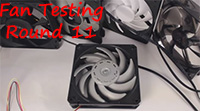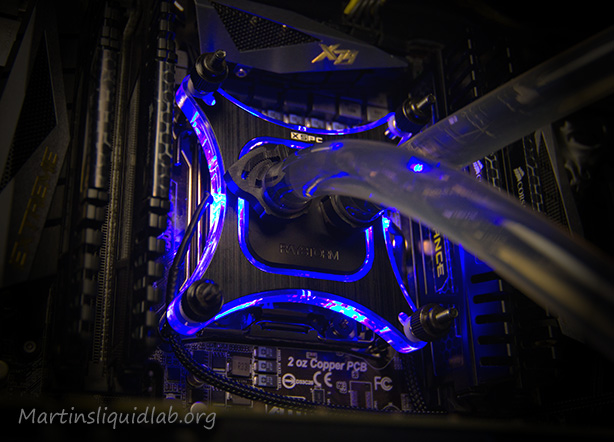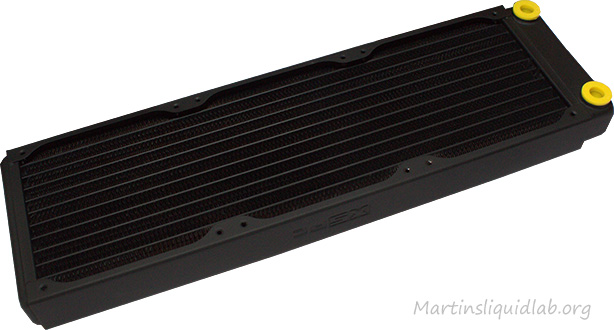Welcome to my second value ($100-$150) 2 x 120mm water cooling kit review, the XSPC Raystorm 750 RS240 DIY Water Cooling Kit w/ Free Dead-Water. These XSPC kits have been very popular among the forum users due to their extreme value and good Do-It-Yourself parts. This kit is very much DIY-custom regarding installation and does not come pre-filled like the AIO units such as the Corsair H100 or Swiftech H220. It does however come packed full of value and the performance level we expect from a DIY-custom water cooling parts. Unlike the sealed AIO kits with their tiny little 1-2watt pumps intended for CPU only needs, this kit affords you flexibility and enough pumping power (6W) to expand later to include a GPU and extra radiator. It also provides your usual DIY flexibility in allowing custom barbs/compression fittings and any flavor tubing you want to suit your custom build needs. Last but not least, it comes in a mostly individual component package (Except for pump/reservoir combo) that makes future upgrading things like the CPU block less costly. XSPC wraps all that up with some additional visual bonuses such as blue LED modules for both CPU block and reservoir that does add some nice visual flare to your custom water build. The kit also comes at the ready with extra hardware to mount external radiators which is something those AIO kit’s just can’t do because you need to route tubes through case walls, etc. In the end it provides you with a big box of water cooling goodness intended to start you in the journey of water cooling without breaking the bank and retaining as much flexibility in installation as possible.
This review is a “LIVING” review as I’m still in the process of testing and writing up the results. If you have testing or review request, please post in the comments.
A very special thanks to Mark from FCPU for sponsoring this XSPC Raystorm 750 kit, your one-stop-shop for all your PC modification supplies.
A quick photo of the Kit’s Raystorm block in darkness action!
Product Description
The XSPC Raystorm RS240 Extreme Universal CPU Water Cooling Kit comes complete with everything you will need to cool your CPU. This kit is designed to handle your CPU and can be expanded to handle more blocks as well.
The kit uses the newest XSPC CPU block, the Raystorm as the core cooling component. This block has a pure copper base and is a top of the line in performance and looks. XSPC coupled this with their RS240 radiator which is a thin profile radiator giving more flexibility with compatibility.
The reservoir is a combination of the XSPC dual bay reservoir along with a XSPC X20 750 pump. This pump has been revised and is much more reliable than previous revisions. It is now injection molded for seamless joints and this new revision 4 model is a black color.
This kit comes compete with all fittings, clamps, fans, mounting hardware and hose.
Note: Kit does NOT come with fluid or additive.
Features
- Designed for Multi-core CPUs
- Complete Kit
- Top End Performance
- Full Copper Base Water Block
Specifications
CPU Block Compatibility: AMD Sockets 939, 754, 940, AM2, AM3
Intel Sockets LGA2011, LGA1366, LGA1156, 603, 604
*Requires mounting holesBlock: XSPC Raystorm – AMD and Intel Sockets: AMD Sockets AM2, AM2+, AM3, AM3+
Intel Sockets LGA1366, LGA1156, LGA1155Base Dimensions: 56mmx56mmx3mm LED Support: 4x 3mm LED Holes Radiator Radiator: XSPC RS240 Dimensions: 121x35x277mm (WxDxH) Ports: G1/4 Screws: 6-32 UNC Fans: 2 x 120mm (4x with push/pull) Reservoir Reservoir: XSPC X20 750 Dual 5.25″ Pump / Reservoir Combo Fitting Ports: 2 x G1/4″ Dimensions: 149 x 100 x 85mm (WxDxH) Tubing and Fittings Tubing: 2 Meters – 7/16″ x 5/8″ Clear Fittings: 1/2″ Barb (Hose Clamps Included) Pump Pump: XSPC X20 750 (Black Revision 4) Pump Performance: 750 lph Delivery head: 1.8m Voltage: 12V (4pin) Fan Fan: 2 x XSPC 120mm x 25mm Radiator / Chassis Fan – 1650 RPM Size: 120mm x 25mm Airflow: 65.2CFM Noise: ~29dBA Static Pressure: 1.8mmAq Operating Voltage: 5.5 – 13.8V. Connector: 3-Pin Wire Length: 45cm Included: RayStorm CPU Waterblock
X2O 750 Pump/Reservoir
RS240 Dual Radiator
G1/4″ to 1/2″ Barb (Black Chrome) x6
Plastic Hose Clip x6
XSPC 1650rpm 120mm Fan x2
120mm Fan Grill (Black) x2
Intel and AMD RayStorm Brackets
Socket 1366 and 1155/1154 Backplates
Socket AM2 and AM3 mounting kit
80mm to 120mm Radiator brackets
3mm Twin Blue LED with 4Pin Molex
5mm Blue LED with 4Pin Molex
2 Meters of Clear 7/16″ Hose
24pin ATX Bridge Tool
K2 Thermal Paste
One particular to take extra note of is that this kit does not come with fluid. It does however come with a bottle of IandH Dead Water (Biocide), so you will need to buy a gallon of distilled water or a liter of water cooling fluid. In spirit of “Value” I chose the first because a gallon of distilled at Wal-mart is only 88 cents which fits this value theme nicely. Also noteworthy is the 1.8m head pump and low restriction Raystorm CPU block that should leave you with some extra pumping capacity to handle adding more to the loop later. There are also several other nice features not expected in a value kit such as the LED modules for pump and block, the 24pin ATX bridge tool to make bleeding easy, and the external radiator mount brackets so you can install the kit on back or on top of cases with limited space. There is quite a lot in just one box..
























